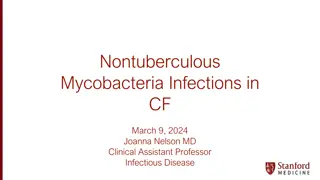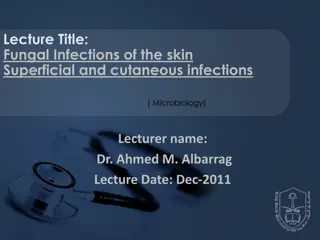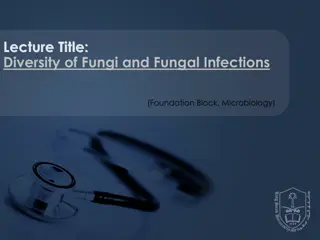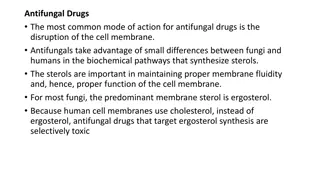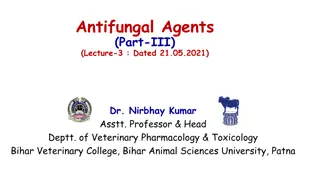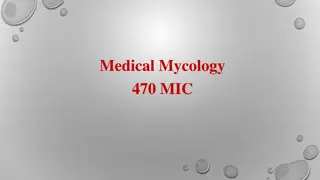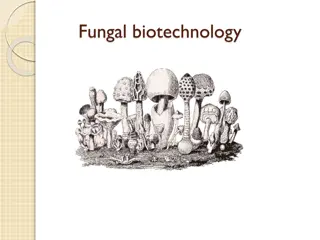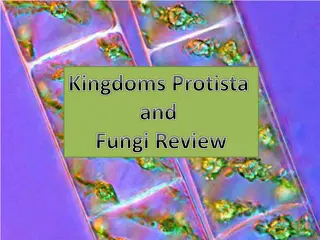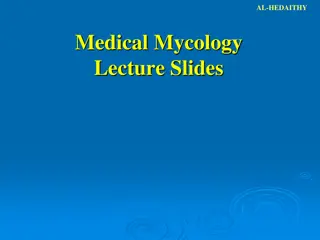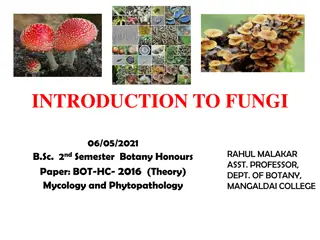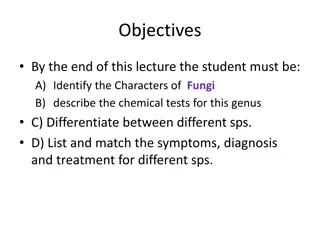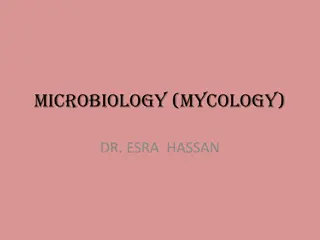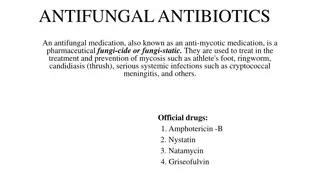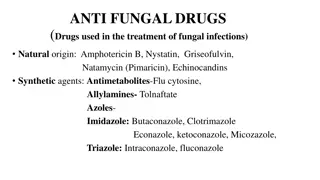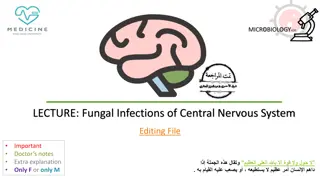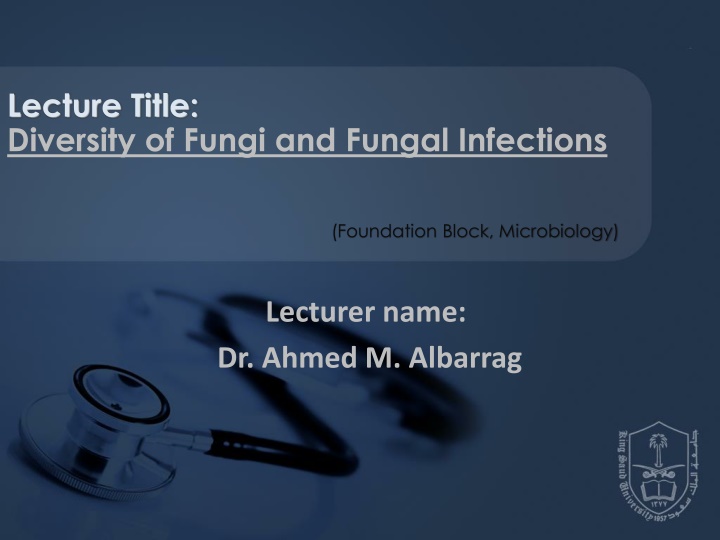
Fungi Diversity and Infections in Microbiology Lectures
Explore the world of fungi and fungal infections with insights on medically important yeasts, mold fungi, antifungal agents, and more. Delve into topics like hypersensitivity, mycotoxicoses, acquisition of infections, and different types of mycoses. Learn about superficial, cutaneous, subcutaneous, and systemic mycoses, along with details on infections in healthy and immunocompromised hosts.
Download Presentation

Please find below an Image/Link to download the presentation.
The content on the website is provided AS IS for your information and personal use only. It may not be sold, licensed, or shared on other websites without obtaining consent from the author. If you encounter any issues during the download, it is possible that the publisher has removed the file from their server.
You are allowed to download the files provided on this website for personal or commercial use, subject to the condition that they are used lawfully. All files are the property of their respective owners.
The content on the website is provided AS IS for your information and personal use only. It may not be sold, licensed, or shared on other websites without obtaining consent from the author.
E N D
Presentation Transcript
Lecture Title: Diversity of Fungi and Fungal Infections (Foundation Block, Microbiology) Lecturer name: Dr. Ahmed M. Albarrag
Lecture Objectives.. 1. To provide students with an overview of the common medically important yeasts and mold fungi. 2. To provide students with an overview of the major fungal diseases that threatens human health. 3. To give a fundamental knowledge about the antifungal agents, their mechanisms of action, and spectrum.
Hypersensitivity (Allergy) Mycotoxicoses Infections
How is the infection acquired? Endogenous, Colonization (overgrowth of normal flora) Inhalation (Airborne) Contact Trauma
(When, which type of infection) Healthy host? OR Immunocompromised host?
Superficial mycoses Cutaneous mycosis Subcutaneous mycoses Systemic mycoses Opportunistic mycoses
Healthy Host Immunocompromised Host Superficial mycoses Superficial mycoses Cutaneous mycosis Cutaneous mycosis Subcutaneous mycoses Subcutaneous mycoses Systemic mycoses Systemic mycoses Opportunistic mycoses
Superficial Mycoses Affect the outer layer of the skin or hair shaft No immune response Cutaneous Mycoses Dermatophytosis Infection of the skin, hair or nails caused by a group of keratinophilic fungi, called dermatophytes
Subcutaneous Mycoses Fungal infections involving the dermis, subcutaneous tissues, muscle and may extend to bone. Usually they are initiated by trauma.
Primary Systemic Mycoses Caused by primary pathogens Contracted by inhalation, Start as respiratory disease Geographically restricted (endemic), north and south America 10
Opportunistic fungal infections Diseases in immunocompromised host Risk factors HIV/AIDS Hematopoietic stem cell transplant (HSCT) Solid organs transplantation Malignancies Neutropenia Diabetes Many others
The Fungi A) Opportunistic Fungi Normal flora Candida spp. Other yeast Ubiquitous in our environment Aspergillus spp. Zygomycetes spp. Cryptococcus spp. B) Primary Pathogens Dermatophytes Endemic geographically restricted - Histoplasma spp. - Blastomyces spp. -Coccidioides spp. -Paracoccidioides spp Other fungi
Clinical features (history, risk factors, etc) Imaging Good value in diagnosis and therapy monitoring Lab Investigations Histopathology Microbiology Other Lab investigations
Cell membrane Polyene Azole Cell wall Echinocandins Caspofungin Micafungin Anidulafungin DNA/RNA synthesis Pyrimidine analogues - Flucytosine
Amphotericin B, lipid formulations Nystatin Mechanism of Action Amphotericin B (MOA): Binds to ergosterol within the fungal cell membrane resulting in formation of pores which permit leakage of intracellular contents, and lead to death . Amphotericin B has a broad antifungal spectrum which includes most fungi that cause human disease
Fluconazole Ketoconazole Itraconazole Voriconazole Posaconazole Miconazole, clotrimazole Mechanism of Action Inhibits synthesis of ergosterol, the major sterol of fungal cell membrane.
AzolesSpectrum of Activity Fluconazole Itraconazole Voriconazole Posaconazole +++ - + +++ +++ +++ +++ Yeast ++ Mold , e.g Aspergillus - - - ++ Zygomycetes
The Fungal Cell Wall mannoproteins 1,3 1,6 glucans Cell b1,3 glucan synthase chitin membrane ergosterol Introduction to Medical Mycology. Merck and Co. 2001
Caspofungin Micafungin Anidulafungin Mechanism of Action Inhibits B-1,3 D glucan synthase, the enzyme complex that forms glucan polymers in the fungal cell wall. Glucan polymers are responsible for providing rigidity to the cell wall. Good activity against Candida spp Aspergillus spp
Target Group Mechanism of action Antifungal Agents Spectrum of activity Comments Cell membrane Polyenes Binds to ergosterol within cell membrane, formation of pores which lead to cell death Amphotericin B, Nystatin Broad antifungal spectrum which includes most fungi Serious toxic side effects (nephrotoxicity) Azoles Inhibit the synthesis of ergosterol Ketoconazole Itraconazole Fluconazole Voriconazole Posaconazole Miconazole clotrimazole Fluconazole has a limited or no activity against mould fungi Voriconazol is the drug of choice for Aspergillosis Posaconazole has broader spectrum of activity than other azoles Not effective against zygomycosis (except posaconazole) Adverse Effects Drug Interactions Inhibits glucan synthesis, (glucan polymers in the fungal cell wall) Cell wall Echinocandins Caspofungin Micafungin Anidulafungin Good activity against Candida spp ,Aspergillus spp Limited or no activity against other fungi Less toxicity and side effects compared to amphotericin B and azoles DNA/RNA synthesis Pyrimidine analogues Fungal RNA miscoding Interfering with DNA synthesis Flucytosine Restricted spectrum of activity Candida species Cryptococcus neoformans Monotherapy now limited (Resistance)
Thank You (Foundation Block, Microbiology) Dr. Ahmed M. Albarrag

